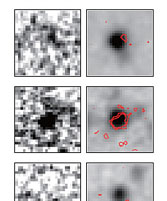Strong UV Radiation Detected in the Most Distant Galaxies
| Science

A team of astronomers from the National Astronomical Observatory of Japan, Osaka Sangyo University, Tohoku University, and Laboratoire d'Astrophysique de Marseille, France have used the Subaru Telescope in Hawai'i to detect strong ultraviolet (UV) radiation from galaxies that lie about 12 billion light-years away. This radiation, which ionizes hydrogen atoms, marks the end of the "cosmic dark age" and heralds the so-called "epoch of reionization" that occurred about a billion years after the beginning of the universe. Although this cosmic reionization was spurred by ionizing radiation from the first generation of galaxies, there have been only two definite detections reported so far. As a result, it has been unclear how much galaxies contributed to the cosmic reionization.
Thanks to the unprecedented performance of the prime-focus camera on the Subaru telescope, the team detected ionizing radiation from 17 galaxies at once. This result suggests that galaxies with strong ionizing radiation could well have played an important role in the cosmic reionization and helps astronomers understand the processes that led to the end of the cosmic Dark Age.
Link
More info: Subaru telescope web page